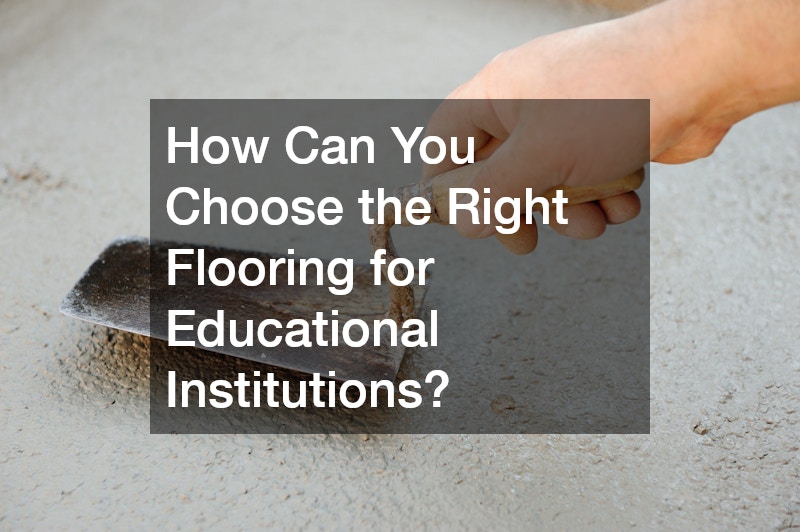Introduction
Understanding the types of flooring education institutions use can help policymakers, designers, and administrators make informed decisions. This article explores the most common flooring options, their benefits, and considerations for different educational settings. By assessing the needs and priorities of various educational spaces, informed decisions can be made to create optimal learning environments.
What Are the Most Common Flooring Types in Schools?
Vinyl Flooring
Vinyl flooring is widely used in schools due to its durability and ease of maintenance. Educational facilities benefit from vinyl flooring as it resists scratches, scuffs, and stains, making it ideal for high-traffic areas.
Additionally, vinyl flooring is often preferred for its varied designs that can emulate more expensive materials like wood or stone, adding aesthetic flexibility without a high cost.
The installation of vinyl flooring is typically quick, allowing schools to minimize downtime during renovations or new constructions. It also boasts excellent moisture resistance, which makes it suitable for areas prone to spills or humidity, such as cafeterias and bathrooms. Furthermore, vinyl flooring can be a cost-effective solution, aligning with budgetary constraints faced by many educational institutions.
Carpet Flooring
Carpet flooring provides comfort and noise reduction, making it suitable for specific areas in schools. Classrooms and libraries, where a quieter environment is necessary, can benefit from carpet’s sound-absorbing properties. Soft to the touch, carpet offers a warm and welcoming ambiance that can be particularly beneficial in spaces catered to younger children.
The cushioning effect of carpet can also enhance safety by reducing the risk of injury from slips and falls. This makes it an excellent choice for areas where students frequently sit or play on the floor, such as preschool classrooms and informal reading areas. Carpet is available in tiles or broadloom styles, offering design flexibility to match different parts of an institution.
Rubber Flooring
This subsection examines the use of rubber for flooring education institutions, highlighting its safety features and resilience. Known for its slip-resistant qualities, rubber flooring is an excellent option for gyms, play areas, and science labs where safety is a primary concern. Its shock-absorbing properties can help prevent injuries during physical activities, providing a safe surface for students.
Rubber flooring is also appreciated for its durability and eco-friendly production, often made from recycled materials. Its inherent elasticity means it can withstand heavy items being moved across its surface without permanent damage. Additionally, rubber flooring contributes to noise reduction, making it a practical choice for connecting corridors where soundproof properties enhance the comfort of neighboring classrooms.
How Can You Choose the Right Flooring for Educational Institutions?
Durability and Maintenance
Selecting flooring that withstands high traffic and requires minimal upkeep is essential. Schools experience significant wear and tear daily, so choosing materials that stand up to such conditions is critical. Durable flooring like vinyl or rubber can reduce the frequency of replacement, thus saving on costs over time.
Maintenance is equally important, as educational institutions often operate with limited cleaning staff. Flooring that is quick to clean and maintain ensures that quality is upheld without imposing additional workload. Materials that resist staining and damage can help maintain the school’s aesthetic and functional value.
Safety and Comfort
Ensuring student safety and comfort is a priority. Flooring choice can directly impact the wellbeing and learning atmosphere of students. Therefore, it is crucial to consider slip-resistance, allergy concerns, and temperature regulation when making your decisions.
Materials such as rubber and carpet can be particularly effective in enhancing the safety and comfort of educational settings. For example, carpets can trap dust and allergens, requiring regular cleaning to prevent any negative impacts on indoor air quality. Conversely, rubber flooring inherently minimizes dust accumulation and provides a cushion against falls.
Cost and Budget Considerations
Balancing quality and budget is crucial for educational institutions. Schools often operate under strict financial constraints, requiring cost-effective solutions that do not sacrifice durability or safety. Vinyl and rubber often present budget-friendly options while meeting these key criteria.
While the initial investment is a significant consideration, it’s equally important to evaluate the long-term expenses associated with maintenance and replacement. Cost-effective choices should ideally require minimal upkeep and have a long lifespan. Therefore, understanding lifecycle costs can help achieve the best financial outcome.
Conclusion
When it comes to the flooring education institutions use, choosing the right flooring involves considering several factors, including durability, safety, cost, and the specific needs of each space. By understanding the advantages and applications of different flooring types, educational facilities can create environments conducive to learning and safety. Decision-makers should carefully evaluate each option’s benefits and drawbacks to ensure a balanced and informed flooring selection process.

